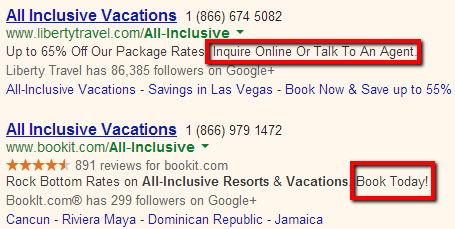As you head down the road that is ad copy creation, the first stop you want to make is text ads. Text ads are one of the most commonly used ad formats. These ads can be used both in the search and content networks. For this post we’ll be looking specifically at running text ads on Google. These same tips can apply to running text ads on any engine; some of the details just might be a little different!
Text Ad Components
Text ads have four main components that the user can see. Here’s an example:

First is the headline which shows up in blue and links to your landing page. Below the headline you will see the display URL which appears in green. This does not have to be the exact URL of your landing page but rather a shortened, simplified version of the destination URL. Below that are your description lines, you get two of them. This is where you can put the key message you want to get across and where you can describe your product or service.
Dynamic Keyword Insertion
Dynamic keyword insertion (DKI) is a feature that allows your exact keyword to show within your ad copy. You can use DKI within any component of your ad, although you generally see it being used in the headline. In order to use DKI you have to use this code within your ad text: {keyword:default text}. This will pull in whatever keyword the search query is matching to within the same ad group that this ad is running in. You also want to enter a default text within this code to tell Google what text to show if your keyword exceeds the character limits. You can also specify how you want the keyword to be capitalized based on how you write that code. For example, if you want the first letter of the first word in your keyword to be capitalized you’ll want to write the code as: {Keyword:default text}. Google has some great tips here on all the different options for using keyword insertion and capitalization!
Some Text Ad Best Practices
♦ Keyword “stuffing” – don’t over-do it!
Keyword stuffing refers to the practice of including related keywords as many times as possible within your ad copy. While it is definitely important to have the keyword in the copy, you don’t want it to be over kill. A general best practice is to include the keyword within the headline of the ad so that it appears bolded within the SERPS. That’s right, when your ad text matches what a user searches, Google will make the text bold within your ad to make it appear even more relevant. Look at the bolded text in this ad when I search “all inclusive vacation”:

♦ Calling To Action
Tell people what you want them to do! Having a call to action within your ad copy can be very helpful because you’re being upfront with searchers and telling them exactly what you’re asking from them and what you can offer. Many advertisers put their call to action within the second description line to try to drive their point home. This isn’t written in stone though; you can try putting the call to action anywhere within the ad, maybe even test it in the headline!
Liberty Travel and Bookit have calls to action in use for vacation searchers with “Talk to An Agent” and “Book Today!”

♦ Be Different (and catchy!)
Chances are you’re not going to be the only advertiser bidding on these keywords. Ad copy is where you have a chance to make your brand stand out. So, use compelling language to grab the user’s attention. Also, try to include some key value propositions within your copy to show users why they should click on your ad versus the plethora of other links filling the page. A good example of this might be calling out special offers like “Free Travel Insurance” or “70% Off Vacation Packages”.
♦ Stay Relevant – all the way down to the Display URL
Keeping your ad text and URLs relevant are key to a positive user experience. You want to show searchers that you can offer them exactly what they’re looking for. You also want them to know that when they click on your ad they will be taken to an equally relevant landing page. That’s where the Display URL comes in. You can modify the Display URL to match the search topic. You could even use keyword insertion to put your keywords in there like Luxury Link did here when I searched “resorts”:

♦ Use punctuation!!
Make the user feel as excited about your product/service as you are! Using punctuation within your ad copy can help make it look cleaner and less spammy while also accentuating key points. Be careful though, over punctuating can get your ad disapproved!
Another tip is to use punctuation at the end of your Description Line 1. While this is not completely necessary, it can be helpful if your description lines are two completely separate sentences. If your ad shows at the top of the page, Google may show both descriptions on one line. Check it out:

This can make it look like a run-on sentence or make it confusing if there is no punctuation between the two phrases.
Now that you know some basics for text ads, keep these tips and tricks in mind and go write some rock star text ads. And check back in next week to learn about image ad options & best practices!

